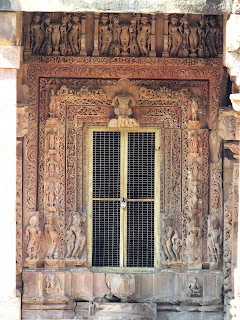Gyaraspur Monuments - A little known architectural wonders in Madhya Pradesh
Gyaraspur - One name which many may not have heard of unless you have some association with Vidisha district of Madhya Pradesh. Its is situated around 35kms from town of Vidisha on Vidisha - Sagar road. The name it seems was derived from a fair which is held at the eleventh month of Hindu calendar hence the name Gyaras and pur meaning a small town. Irony is most don't even know that there is a statue of lady called "Shalabhanjika" kept at Gujari Mahal museum - Gwalior which is considered a matchless beauty by many historians and experts. The statue is called as Indian Venus or Monalisa statue in stone. It was discovered in Gyaraspur.
History: The Kachhapagatha dynasty ruled the North West parts of Madhya Pradesh during the 10th and 12th CE. They are assumed to be progeny of the Nagas and were the vassals of Gurjara - Pratiharas and later of the Chandelas of Central India. This dynasty contributed much to art and architecture and many temples were built under their patronage. Their early work followed the Gurjara - Pratiharas style and later developed unique and new trends in temple constructions.
Gyaraspur was of considerable importance in medieval India. The extensive ruins scattered around narrate the glory of Gyaraspur in the late and early medieval times. The ruins indicate the place has passed through the influence of Brahmanism, Jainism & Buddhism. Since its a small town all monuments can be visited walking around.
1) Maladevi temple: This 9th century temple is situated around 1.5kms from the bus stand on a small hill overlooking a valley. Its seems part of the hill was scooped out to built this temple on a massive platform and strengthened by massive retaining wall. The Pratihara period temple is constructed on eastern slope and temple structure has an entrance, hall and shrine. The Shrine is surrounded by very ornate passage. As per the caretaker who acted as our guide, the statues of Hindu goddess which though are missing, were present on all the sides of the temple like a garland and hence the name Mala devi.
Inside the sanctum four Tirthankara's can be seen seated in padmasana. Ornamented with Jain Yaksha, Yakshini and Hindu deities on outside. The Sanctum entrance has block on outer frame of goddess Ganga & Jamuna while richly carved shikhara above the sanctum has Vaishnavi seated on Garuda. The pillars outside as well as inside the temple is ornamented with beautiful designs. The sculptures probably indicate that the temple was originally dedicated to some goddess and it was subsequently appropriated by the Jains.
Today the sanctum sanctorum is a very crumbling state due to which no one is allowed inside the temple. Beehives can be seen inside the rocks. But good news is that MP tourism & ASI would be jointly commencing the work to restore the temple to its lost glory soon.
2) Hindola Toran: It is one of the most beautiful ornamental entrance arches or Toranas to a now destroyed Vishnu or a Trimurti temple. What remains today is these two lofty pillars with a cross beam intricately carved into panels with insets of ten incarnations of Vishnu. Words fail to describe this intricately carved monument and its a visual treat to the eyes.
3) Chaukhambha: This monument is part of Hindola torana where the Chaukhamba would have been four pillars of mandapa of a Brahmanical temple and torana would have been ornamental entrance arch to the shrine. Chaukhamba, which are equally adorned by ornate carvings on all sides, means four pillars and sadly that is what only remains of what once would have been a beautiful temple complex. The ruins of larger temple complex can be seen scattered around the monuments.
As per our guide and caretaker of the monument, ASI has plans for this monument to be restored back and work would commence soon. MP tourism has created a boundary wall and garden in the complex as there is a caretaker present in the compound 24/7.
4) Athkhambha: Located close to bus stand, is set of delicately carved eight pillars which could have been columns of what was suppose to be a 9th century Shiva temple. Looking at the ornamented pillars shows the high degree of craftsmanship of sculptors of those days.
5) Bajramath Temple: Situated at little away on the south side of the village is the triple shrine temple complex called Bajramath. The entire triple shrine is in single row of same structure. The 10th century temple gates, door and back parts are engraved with Shiva, Brahma and Vishnu. This temple was transformed into Jain temple at a later date during which time the Tirthankara statues were established. Varaha avatar of God Vishnu, Narasimha, Shiva can be seen on the niches on the external wall. Bajramath is yet another fine example of very rare class of temple with three shrines and shows the exemplary craftsmanship of sculptors of the time.
6) Dhaikinath Stupa: This is about 1.3kms from the bus stand and there is straight road near the Athkhambha monument which leads to the stupa. The Hemispherical dome on circular berm is incompletely preserved. Nothing much to see here except the 7th century monument.
Gyaraspur is small village with no proper lodging facility but small eateries can be found on the main road. Regular bus services are available to & from Vidisha where we stayed. Auto rickshaw can also be hired from Vidisha for half day trip to Gyaraspur. Further ahead around 90kms from Vidisha is town of Udaypur which is also famous for its art & architecture that flourished under Parmar rulers of 11th century.






































Awesome
ReplyDeleteThanks
Delete